PARROTS
Parrots eat a variety of seeds, flowers, leaves, insects, grubs, native fruits and berries. Cockatoos and Rosellas will also raid fruit orchards. Many parrots have also developed an appetite for wheat, sunflower seeds, corn and other crops.
The Parrots' breeding season lasts from August to January when more food is available. However, some species in dry areas will breed after rain in any season.
Parrots usually nest in tree hollows, though some rarer species will nest in termite mounds or on the ground.
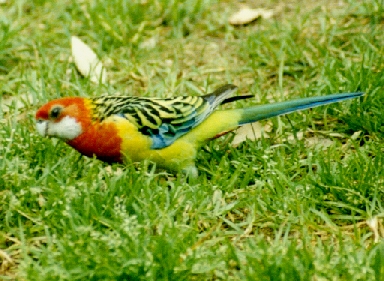
Above: An Eastern Rosella having a feed on grass seeds.
|
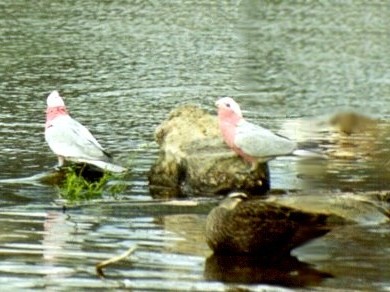
Above: A pair of Galahs drinking water from a lagoon with a Pacific Black Duck having a nap in the foreground.

|
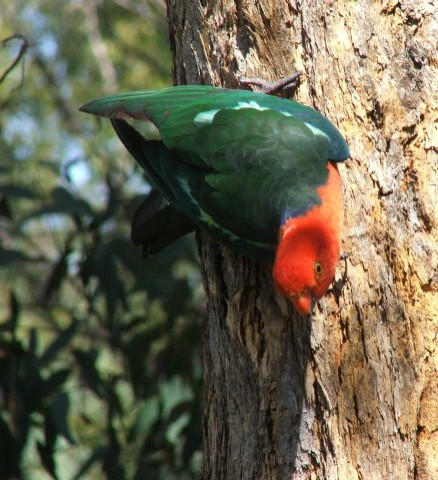
Above: A Male King Parrot foraging for seeds on the tree top. The Male King Parrot has the most distinctive red chest with bright green wings, whereas the female and young ones are covered mostly with green.
|
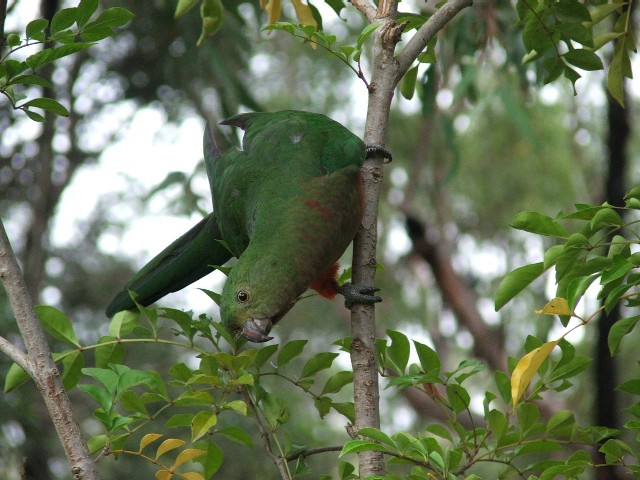
Above: A Female King Parrot looking for seeds on an Evergreen Ash tree.
|
The loud raucous noise that parrots make are a form of communication. The various calls indicate warnings of danger, locations of food, distress calls and even a food-begging call. These calls are sometimes accompanied by movement, so that the flash of colours becomes part of the message as well.
While illegal trapping and smuggling operations of live birds have contributed to the decrease in Australian parrot populations, the removal of eggs from the nests, poses a bigger threat. It is easier to obtain and transport eggs than adult birds. All parrots are legally protected throughout NSW by the National Parks and Wildlife Act, 1974.
LORIKEETS AND HONEYEATERS
These birds feed on nectar from flowers. This diet is quite complex and it is supplemented with the protein from insects and pollen.
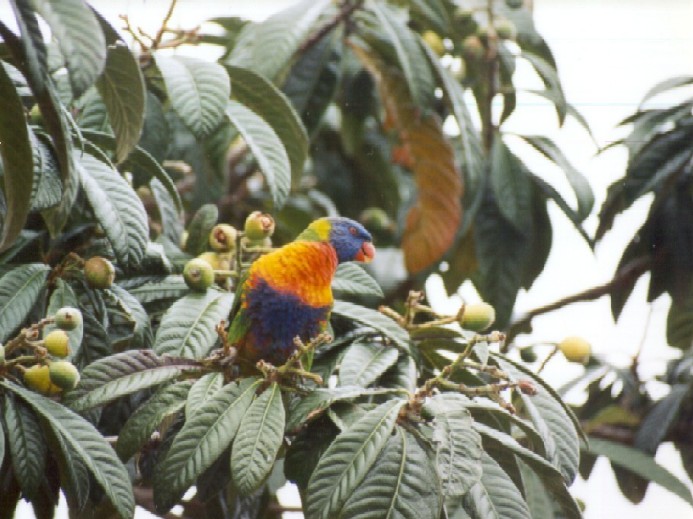
Above: A Rainbow Lorikeet on a Loquat tree. These birds love to eat fruit
and nectar.
|
|
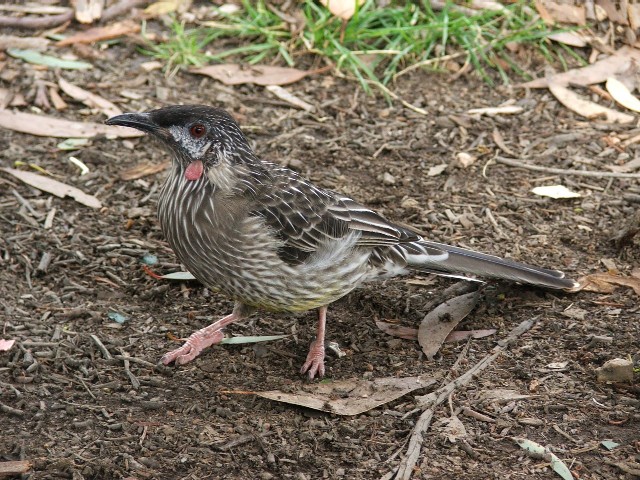
Above: A Red Ear Wattle Bird searching for insects on the ground
|
Their digestive system is not designed to cope with seed, bread or fibre, except in very small quantities. Feeding honey or sugar water to these birds satisfies their hunger so they do not seek out the natural nectar from flowers. They become undernourished and more susceptible to disease. Vitamin deficiency can cause foot and leg paralysis and poor feather growth.
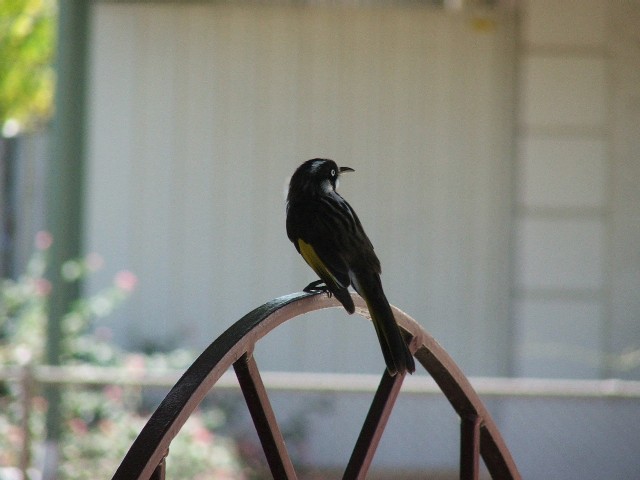
Above: A New Holland Honey Eater sitting on a fence. They fly between shrubs in the gardens in search of nectar.

|
In summer, these sweet mixtures deteriorate rapidly and become an ideal source for spreading bacterial infections among the birds.
Normally in winter, lorikeets disperse in search of blossoms but, as a result of artificial feeding, they are staying in the colder climates and breeding throughout the winter.
Winter babies have great difficulty surviving.
KOOKABURRAS, MAGPIES, CURRAWONGS AND BUTCHER BIRDS
These birds mainly eat insects and small reptiles. They are all territorial and live in family groups. The Magpie is sometimes aggressive to humans for a few weeks in the breeding season as it is protecting both nest and young.
Magpies and currawongs build nests high in trees. Both parents assist in the raising of their young. It is normal for young birds to spend a few days on the ground before they can fly while their parents supervise and protect them.
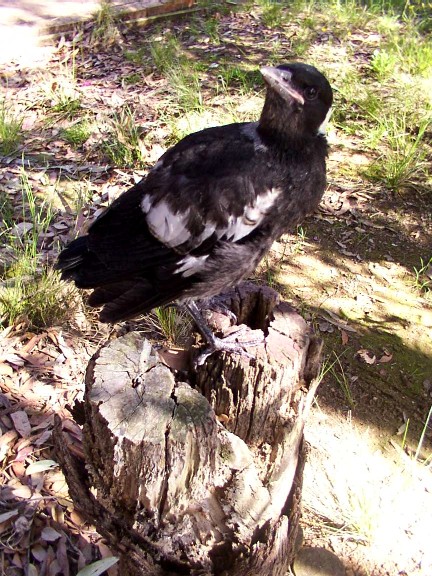
|
Left: This baby Magpie is eagerly waiting for its parents to return with some food
|
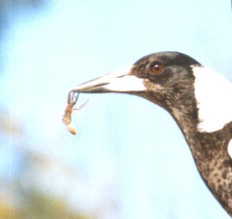 |
Left: The father Magpie returns with a fresh catch of a Huntsman Spider

|
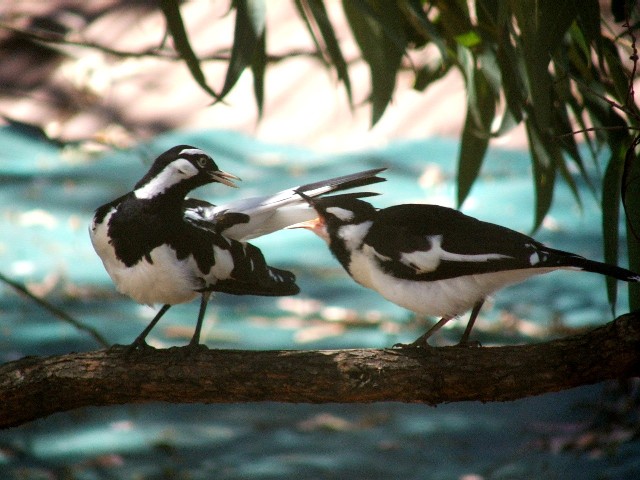
Above: A baby Magpie-Lark (Peewee, Mudlark) begging for food from Father.
The male has black on the throat whereas the female has white.

|
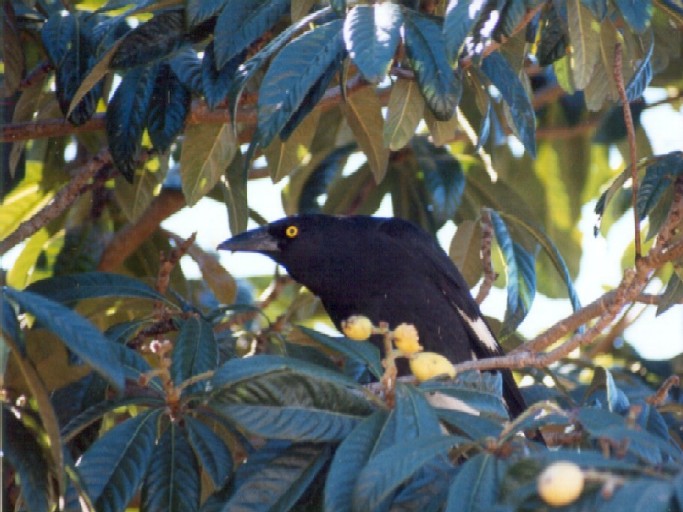
Above: A Currawong peaking through the thicket to investigate the disturbance. Notice the yellow eyes and white patch on the wings.
|
Despite the larrikin image given by the raucous laughter, this famous Australian bird takes family duty seriously. It is of course the laughing kookaburra, which usually stays with mum and dad for several years, helping feed, raise and protect its younger brothers and sisters. Young Kookaburras are reared in high tree hollows and fed by several members of the family.
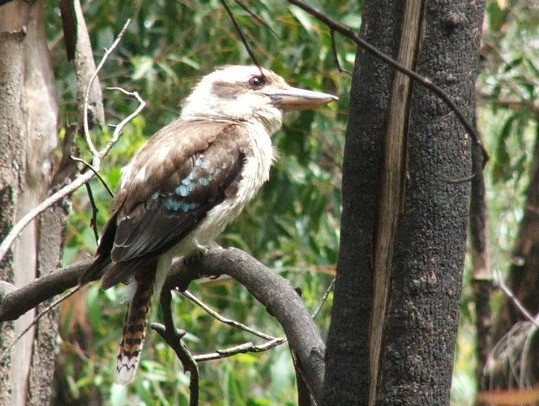
|
Left: A Laughing Kookaburra watching out for prey from the tree top.

|
When a kookaburra eventually starts a family of its own it will usually keep that mate for life. And that's real commitment as kookaburras may live for 20 years!
To let other kookaburras know about its home territory a family group will laugh throughout the day, especially around dawn and dusk. Disputes over territory are usually resolved with complicated flight displays involving a bird from each group. Very rarely do they result in tough physical battles.
A Kookaburra family needs a large area with big trees and garden areas in which it can safely search for food. Its home territory may include over one hundred house blocks and some parkland. Our neighbourhoods can be friendly for kookaburras. That's why the NSW National Parks and Wildlife Service, local councils and other interested groups have started a program called Backyard Buddies. For more information on Backyard Buddies, visit the website http://www.backyardbuddies.net.au.
A Bower Bird is one of the most amazing creatures. During mating season, the male Bower Bird makes a Bower out of twigs and sticks and then decorates the Bower with blue objects such as pegs and ribbons. The more attractive the Bower the more likely it will be that the male will attract a mate.
Many of the birds rescued by wildlife rescue organisations suffer ill health because they have been fed by well meaning people. Beef or mince is a poor diet for these birds. Their natural diet is the whole animal. This includes fur, bones and organs, rich in vitamins, minerals and fibre essential for healthy development.
SUPERB FAIRY-WRENS
These beautiful birds live in family groups. They feed and hunt in groups along thickets and undergrowth. The family of birds will occupy a large territory where there are plenty of insects. Wrens often establish a hunting path that they follow day in day out. Only the breeding male Wrens exhibit the bright and deep blue colours which are used to attract the females, whereas the females of the species and non-breeding males are light brown in colour.
Wrens build their nests close to the ground, often inside thorny thickets to avoid predators. The males often can be heard providing a shrilling cry to warn others of approaching danger. They are quick and brave in nature and will get quite close to human beings.
|
Right: A male Superb Fairy-Wren watching out for insects
|
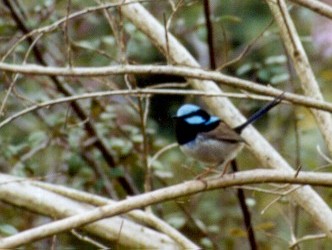

|
DUCKS AND WATER BIRDS
Australia is the smallest continent and largest island in the world. Therefore, Australia is surrounded by water creating a perfect home for many water birds. The advantage of being surrounded by water means that there are many rivers, streams and lakes along the coastal regions, providing many habitats for water birds.
There are two types of native ducks that are common and probably familiar to most people. These are the Maned Wood Duck (Wood Duck) and the Pacific Black Duck (Black Duck). These ducks are quite different in appearance. The Wood Ducks are smaller and lighter than the Black Ducks, and they are better at flying.
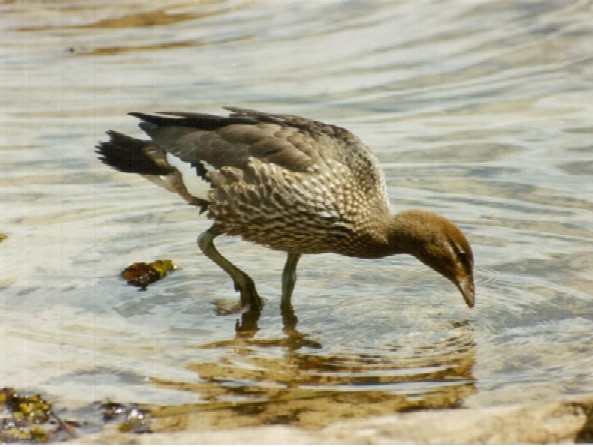
Above: A Female Maned Wood Duck searching for food in the water.
|
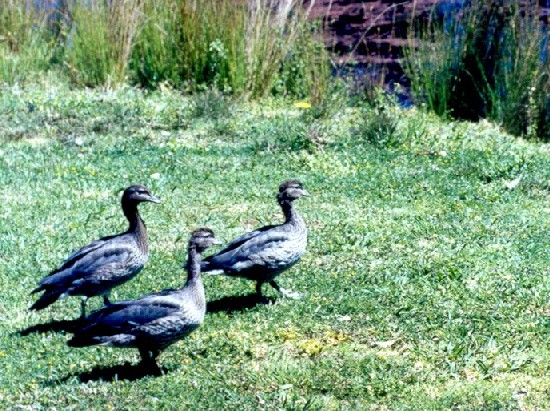
Above: A group of Wood Ducks heading toward the lake for a swim.

|
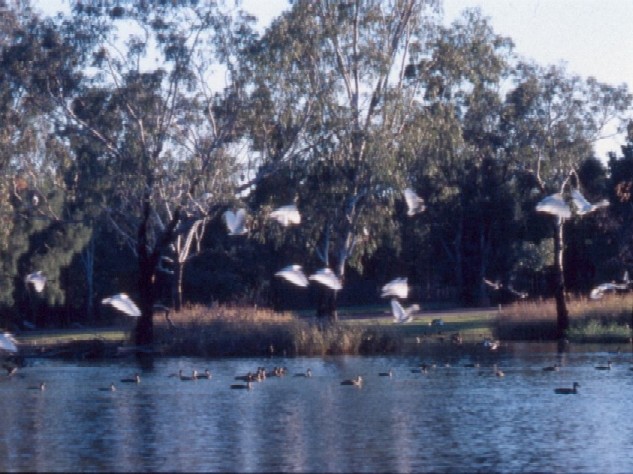
Above: A flock of Ibises taking off to roost
|
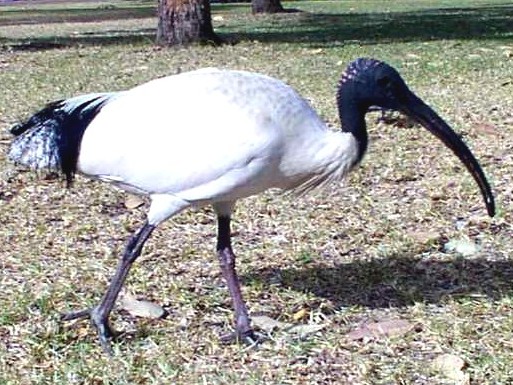
Above: An Ibis foraging for food

|
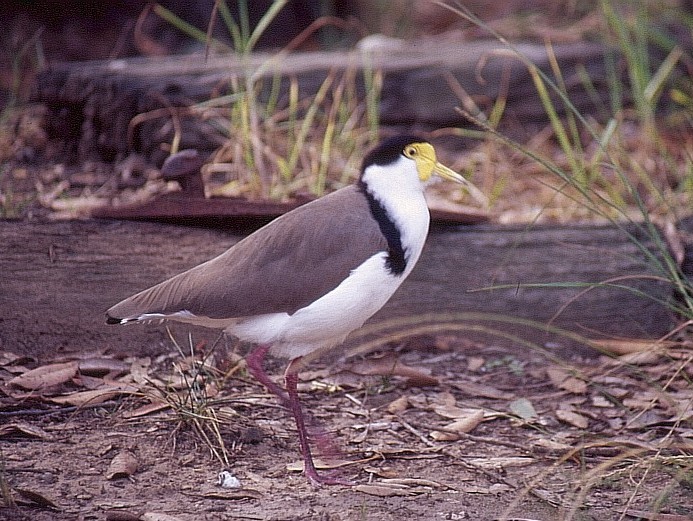
Above: A Plover guarding its nesting site

|
|
PIGEONS
Australia has several species of pigeons but the most common one is the Crested-Pigeon, which is often confused with the introduced Spotted Turtle Dove. Both male & female Crested-Pigeons have a distinctive black crest which points upright. The male courts the female by bobbing up and down, and at the same time spreading its tail feathers like a fan.
HOW YOU CAN HELP?
You can do the following to help provide a comfortable environment for our birds:
- Plant large gum trees in your backyard, local council area, or local parks. The large trees will contain hollows and stout branches for the birds to nest and shelter.
- Plant native shrubs and flowers to provide shelter and food source for birds.
- Use mulch in your gardens. The leaves and mulch provide homes for small lizards and insects, which in turn provide a perfect natural food source for birds.
- Provide a place that is free from cats, dogs and foxes. Take precautions to prevent predators from destroying our wildlife. Take steps such as keeping your cats and dogs in at night time, and putting fences up to prevent foxes from getting to the trees and bushes.
- Avoid using garden pesticides. The pesticides will contaminate the insects which will eventually poison our wildlife that feeds on the insects.
- Build a bird bath in a safe place near some shrubs and bushes. Make sure that the bird bath is above the ground and away from the house. Birds love to splash around on a hot day and will use the bath more often if they know that it is a safe environment. Keep dogs and cats away from the area at all times and make sure that you clean the bath at least twice a week.
Back to home page
|
